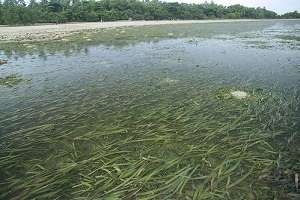Dr Laverock says seagrass can take-up nutrients directly from the water/sediment via their leaves or roots. Credit: Ria Tan
Little is known about the microbial ecology of Cockburn Sound – but researchers from the University of WA and Edith Cowan University are investigating its seagrass root and rhizome sediments and how the presence of seagrasses enhances microbial functions.
UWA Indian Ocean Marine Research Centre research fellow Dr Bonnie Laverock is exploring how microbes contribute to both the success and productivity of seagrass seedlings and adult plants.
"I'm interested in carbon and nitrogen cycling microorganisms and how their processing of organic matter and inorganic nutrients, such as nitrate or nitrite, may affect seagrasses," she says.
"I research microbes using molecular techniques with DNA (deoxyribonucleic acid) and RNA (ribonucleic acid) to investigate the abundance and activity of specific microbial genes.
"Seagrasses are known to have closely associated communities of nitrogen-fixing bacteria in their root/rhizome systems – these bacteria 'fix' nitrogen gas, therefore making it biologically available for uptake by the seagrasses.
"I'm also interested in the overall community structure of the bacteria and how it varies between seagrass beds and in comparison to bare sediments."
Working with colleagues, Dr Laverock aims to link these changes in community structure to differences in carbon mineralisation and nutrient fluxes inside and outside of seagrass beds to better understand microbial processes in seagrass meadows.
Seagrasses can enhance the exchange of carbon and nutrients from the sediment to the water column in several ways.
Dr Laverock says seagrass can take-up nutrients directly from the water/sediment via their leaves or roots.
"These are then converted into seagrass biomass which can be decomposed by microbial communities in the sediment, releasing nutrients and carbon back into the water column," she says.
"The seagrasses also directly exude small dissolved compounds such as sugars and it's thought these sugars allow bacteria to chemotactically locate the roots."
Cockburn Sound has several unique features that enable researchers to study marine microbial ecology and draw comparisons to other areas on WA's coastline.
"The Sound is sheltered from large changes in tides and wave action compared to some areas that are continually disturbed by strong currents and waves," Dr Laverock said.
"This allows us to compare how seagrasses and other sediment organisms respond to physical disturbance from waves, such as during storm events.
"Cockburn Sound also has some good depth gradients, going from shallow to very deep, and some gradients of nutrient enrichment from industrial/agricultural outflow.
"The balance of nutrients in coastal regions is extremely important for ecosystem health and the ways in which microbes process these nutrients could be a key component of that ongoing health."
Provided by Science Network WA






















